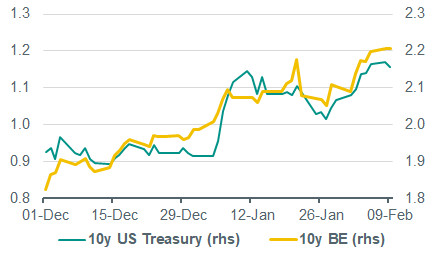Global Daily – Will the Fed put a lid on yield rises?
Fed View: Powell reiterates dovish stance, but offers little else for now. Fed Chair Powell delivered his semi-annual testimony to Congress today. The testimony largely repeated recent views expressed on the recovery and the outlook, including the key emphasis that the Fed is still a ‘long way’ from achieving its goals. Chair Powell also took the opportunity reiterate the Fed’s new policy framework, whereby the Fed would make up for shortfalls in inflation by aiming for moderately above 2% inflation for a time.
Co-author: Jolien van den Ende
While financial markets have largely digested this change, there is still uncertainty over how precisely the Fed will apply this new framework. As a result, markets have moved rather too hastily in our view to price in a tightening cycle. Alongside the significant rise in inflation expectations, this is one of the reasons bond yields have continued to push higher over the past month. Adding fuel to this move has been commentary that has been comparatively relaxed about bond yield rises (in notable contrast to ECB commentary). We continue to think the Fed will remain comfortable with yield rises for as long as they are driven primarily by inflation expectations – i.e. that real yields are stable. However, more recently that has not been the case, and we have also seen yields rising on the back of a repricing of Fed hikes, pushing real yields higher (see below for more). This will be tolerated to a degree, but at some point the Fed will view such rises as getting out of hand and putting an undue brake on the recovery, through a tightening of financial conditions (which can mean equity market falls as well as interest rate rises). However, before this, the Fed’s own new projections (released on 17 March) will likely show that market expectations for policy rate hikes have gotten ahead of the likely reality.
Inflation expectations as well as rate hike expectations have driven US yields higher – The rise in US yields has been driven by both inflation expectations and a more aggressive pricing in of Fed rate hikes. From early December to 10 February, yields rose mainly on higher inflation expectations, with the 10y yield moving in line with the 10y breakeven yield (see left chart). Meanwhile, fed funds rate expectations remained stable. However, in the last two weeks, the rise in yields has been on the back of more aggressive rate hike pricing by the market. This is reflected in 3y ahead short term rate expectations. Future short term rate expectations are an important driver of longer-term yields, and both the short term rate expectations 3y ahead and the 10y real rate increased by almost 30bp over the past two weeks (right chart).


Source: Bloomberg, ABN AMRO Group Economics
In the dots we trust – Indeed, based on the forward swap curve in the US, the market is pricing in a relatively aggressive rate hike cycle, beginning already in the first half of 2023; our base case is for rate hikes to begin at the end of 2023. Markets are arguably operating without a real anchor at present, because the FOMC has yet to officially indicate the implications of massive fiscal spending on rate hike expectations. The last time we got a full set of ‘dots’ projections was in December, before the January run-off elections which handed Democrats that crucial Senate majority. However, this will change in 3 weeks’ time, when the Fed publishes a new set of projections on 17 March.

Source: Bloomberg, ABN AMRO Group Economics In the near term, yields could continue to grind a little higher, although we expect the Fed to step up the dovish rhetoric if rate hike expectations get too far ahead of themselves – particularly if this leads to a sharp correction in risky assets. The new March projections will likely show some shift higher in expectations for rate hikes – in particular, we expect the median ‘dots’ to show one rate hike by end 2023 (as of December, only a handful of FOMC members expected such a move). However, given the Fed’s average inflation targeting framework, the dots are unlikely to show a quicker pace of rate hikes than this; our base case is that the first move will come at the end of 2023, with a very gradual pace of tightening (two hikes per year) thereafter, which is less aggressive than the market is currently pricing in. We also think the end-point for rate hikes will be a lot lower than in the past, reflecting a likely fall in the neutral rate. As such, and given current market pricing, yields are likely to be capped once the new projections have been published.
Further ahead, we expect yields in the US to fall back, and curves to flatten – Inflation expectations are currently around the levels we saw in 2018, but the macro-environment we are facing is a very different one. Indeed, we still expect spare capacity in the economy at the end of this year. Moreover, it will take 2-3 years before we are back at full employment levels. Besides this, although we see some temporary upward pressure on inflation due to oil prices, we expect this to reverse later in the year. As such, inflation expectations are probably on the high side at present. Once the markets starts to price out these elevated inflation expectations, yields should fall back on this, as well as a reduction in rate hike expectations. This would result in lower long-end yields and flatter curves, taking the 10y US Treasury yield back down to 1.2% in the course of the year. (Bill Diviney & Jolien van den Ende)
